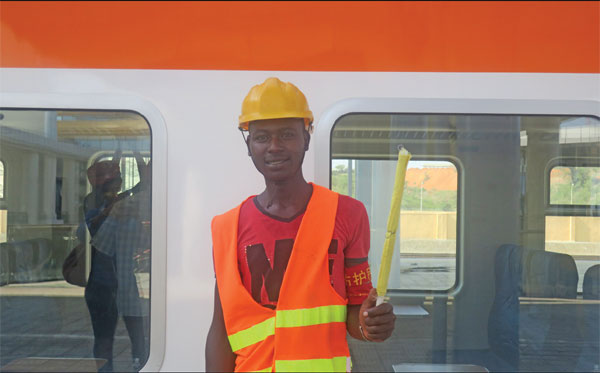Careers on fast track to bright future
By Lucie Morangi (China Daily Africa) Updated: 2017-04-30 14:26As opening of major railway project looms, Kenyans are enjoying better job prospects
New infrastructure gives birth to hope, and that is what has happened for Robert Kobia. The 24-year-old man from Meru, a town in eastern Kenya, has seen his life transformed within two years of joining the local team constructing the Standard Gauge Railway, Kenya's biggest infrastructure project since independence in 1963.
His current position as a safety worker is a far cry from the job as a mason that he took when he joined the China Road and Bridge Corp in 2015. With the railway's official launch date fast approaching, more skilled personnel have been recruited to provide the finishing touches along the 472-kilometer Mombasa-Nairobi route.
Since January, Kenya has been taking delivery of locomotives from China. These are transported from the port to the capital city using the new tracks. This has created a need for heightened safety and security measures in the two main stations and thus the need for Kobia's role.
|
Robert Kobia, a station platform safety worker at the Standard Gauge Railway of the Mombasa-Nairobi route. Photos by Lucie Morangi / China Daily |
"Safety is paramount here," says the soft-spoken worker, donning a bright orange and yellow safety jacket while handling green, red and yellow flags. It is obvious that he loves his job as he keeps a close eye on every one walking along the platform at the Mombasa terminus.
Kobia is among four people making up the first safety team for the $3.27 million project. Dexterity in his work as a mason and an ability to quickly administer first-aid to fellow workers made him stand out from his peers. He worked for two months as a mason before he was interviewed for an opening in the safety department and taken to Beijing for training. He successfully completed class A training.
He is now responsible for encouraging and managing the safe behavior of non-passengers on the platform. Although train services have yet to be officially launched, workers at the station need to be guided.
"The locomotive driver alerts me once he departs from Nairobi and from every station along the route," he says. "I have to make sure that people stay within the parameters marked and I have to clear the plat form before the train arrives," he says.
The route has 33 stations in total, including 23 crossing stations, seven intermediary ones and two major stations in Mombasa and Nairobi, where Kobia and his colleagues work in two shifts on a 24/7 basis. The team will be expanded after the launch, slated for June 1.
Kenya has ordered 56 locomotives. Passenger trains are expected to run at speeds of 120 kilometers per hour, cutting the travel time along the route from eight to four hours. Freight trains will reach speeds of 80 km/h. These speeds are unknown to those used to old meter gauge service that runs at maximum speeds of 30 km/h.
The platform has been clearly marked to guide workers-and later passengers. However, it is Kobia's responsibility to ensure that they adhere to the rules and that people on the plat form have basic knowledge of safety precautions. People are not supposed to hurry or stand close to the platform edge to eliminate risks such as slips, trips and falls.
"It is really important that people remain focused and stay alert anywhere near the railway tracks," says Kobia, adding that the new trains are much faster. "The SGR is quieter and travels faster than most people are used to. Much of the new infrastructure runs parallel to the old one along the route, with a distance of 30 meters between them. The track has been raised but people are still unaware of the dangers."
His team has been visiting schools and other public centers along the route to raise awareness of the speeds at which the new trains will be traveling. Although it is a single track, the traffic is expected to be busy. Freight trains will be transporting cargo from the port of Mombasa to the container terminal in Nairobi, later to be transported by road to Uganda or Rwanda.
The government of Kenya is also expecting a boom in the tourism sector as the railway snakes into the Tsavo National Park, where wild animals can be seen. Tourists will also be able to travel between the two cities conveniently.
In the meantime, Kobia is anxiously looking forward to the official launch in a month's time.
"Kenyans will be happy with this infrastructure. Lives will definitely change," he says.
Promotion has meant higher earnings for the father of two. With the impending recruitment of additional personnel in his department, he believes he already has a head start.
"I am sure my experience will hasten their settling-in and make operations here in the Mombasa station smooth and safer for passengers. We are ready for them."
The construction of the SGR has provided 30,000 people with job opportunities along the route. At least 2,000 more are expected to work at management level once the line is officially launched.
lucymorangi@chinadaily.com.cn
- 'Cooperation is complementary'
- Worldwide manhunt nets 50th fugitive
- China-Japan meet seeks cooperation
- Agency ensuring natural gas supply
- Global manhunt sees China catch its 50th fugitive
- Call for 'Red Boat Spirit' a noble goal, official says
- China 'open to world' of foreign talent
- Free trade studies agreed on as Li meets with Canadian PM Trudeau
- Emojis on austerity rules from top anti-graft authority go viral
- Xi: All aboard internet express












